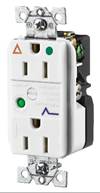


Office plug loads are the loads with the largest power density (W/ft2) in most office buildings. The Energy Standards require controlled and uncontrolled 120-volt receptacles in lobbies, conference rooms, kitchen areas in office spaces, copy rooms, and hotel/motel guest rooms. The requirement of the Energy Standards for controlled receptacles allows these plug loads to be turned off when the space is unoccupied, resulting in energy savings.
For the 2019 Standards, receptacles in healthcare facilities are exempted from the requirement of Section 130.5(d), Circuit Controls for 120-Volt Receptacles and Controlled Receptacles. Healthcare facilities overseen by the California Office of Statewide Health Planning and Development (OSHPD) are brought into the scope of Title 24 Part 6 for the first time; the purpose of this exemption is to avoid potentially conflicting requirements for healthcare facilities.
Figure 8-1: Samples of Receptacles for Hospital Applications



Source: Hubbell Wiring Devices - Kellems
All controlled receptacles must be marked to differentiate them from uncontrolled receptacles.
Either circuit controls or controlled receptacles for 120-volt receptacles can be used for meeting the requirements of Section 130.5(d).
Methods for meeting requirements include the following:
1. For any uncontrolled outlets, ensure that at least one controlled outlet is located within 6 feet of the uncontrolled outlet.
2. Using split wired receptacles that provide at least one controlled outlet.
The requirement does not mean that one controlled outlet must exist for each uncontrolled outlet.
In open office areas where receptacles are installed in modular furniture, at least one controlled receptacle must be provided for each workstation. Alternatively, any controlled circuits already built into the building system can be used to meet the requirement.
The controlled receptacles must be automatically switched off when the space is not occupied. See next section, “Application Considerations,” for example approaches of using automatic means for shutting off controlled receptacles. An automatic time switch with manual override may also be used for meeting the requirement.
Plug-in strips and other plug-in devices CANNOT be used to meet this requirement. A hardwired power strip controlled by an occupant-sensing control may be used to meet the requirement, but a plug-in power strip cannot be used: the intent is for the controlled receptacles to be permanently available, not removable.
There are important exceptions where an uncontrolled outlet is not required to be matched with a controlled outlet. They include:
1. Receptacles in kitchen areas that are specifically for refrigerators and water dispensers.
2. Receptacles specifically for clocks. (The receptacle must be mounted 6’ or more above the floor to meet this exception.)
3. Receptacles in copy rooms specifically for network copiers, fax machines, audio-visual equipment, and data equipment other than personal computers.
4. Receptacles on circuits rated more than 20 amperes.
5. Receptacles connected to an uninterruptible power supply (UPS) that are intended to be in continuous use, 24 hours per day/365 days per year, and are marked to differentiate the receptacles from other uncontrolled receptacles or circuits.
The following are example approaches:
A. Private Offices, Conference Rooms, and Other Spaces With Periodic Occupancy
Occupancy-sensing controls that are part of a lighting control system may be used to control general lighting and receptacles. For example, a common occupancy sensor can control general lighting and receptacles, with auxiliary relays connected to the lights and the controlled receptacles to provide the needed functionality.
B. Lobbies, Break Rooms, and Other Spaces with Frequent Occupancy During Business Hours
Astronomic time-switch controls, with either a vacancy sensor or switch override, can switch the controlled receptacles. Programmable relay panels or controllable breakers can be used, or, for simpler projects, a combination of vacancy sensors and programmable time switches can accomplish the same task. If vacancy sensing is used, controls will likely need to be room-by-room or space-by-space, but if time-of-day with manual override is used, whole circuits may be controlled together.
C. Open Office Areas
Receptacles in open office areas can be controlled by the automatic shut-off system of the building or by controls integrated into the modular furniture systems. If the building provides controls, relays or controllable breakers with manual override switches for zones within an open office space may be used. A system using vacancy sensors might also be considered if sensors can be added as needed to address partitioning of the workstations (thus ensuring proper operation). Systems contained within workstation systems are an acceptable alternative provided that they are hardwired as part of the workstation wiring system.
D. Networked Control Systems and Building Automation Systems
Most advanced lighting and energy control systems can be easily designed to accommodate receptacle controls.
The Energy Standards recognize that certain office appliances, such as computers, need to be powered continuously during office hours to provide uninterrupted services. These would be connected to the uncontrolled receptacles. Other appliances, such as task lamps, personal fans and heaters, and monitors, do not need to be powered without the presence of occupants. These controllable loads would be plugged into the controlled receptacles to ensure they are automatically shut off and to prevent any unnecessary standby power draw. Ultimately, providing controlled receptacles allows building occupants to determine which appliances to be controlled.
In open office areas, it is advisable to implement vacancy sensor control at each workstation or cubicle to maximize the opportunities of shutoff controls. Modular office system furniture is usually equipped with more than one internal electrical circuit, and some of these circuits can be dedicated for controllable plug loads.
When demand-response controls are installed at the power distribution system level (for example, circuit-level controls), the controls must comply with §110.12(a) and may need to comply with additional requirements if they are specifically intended to control HVAC or lighting systems. See Appendix D of this manual for guidance on compliance with the demand-responsive control requirements.